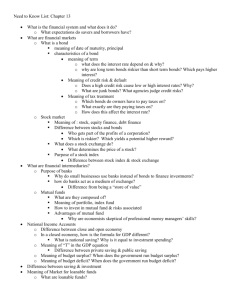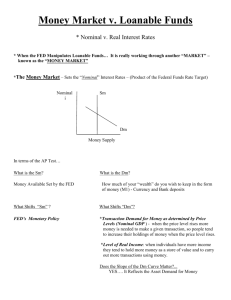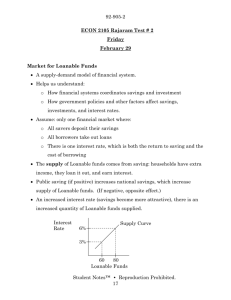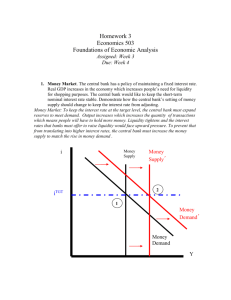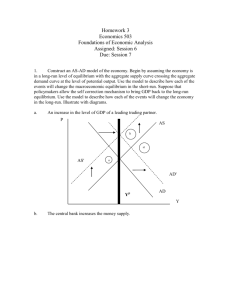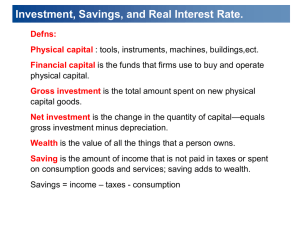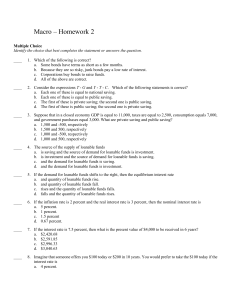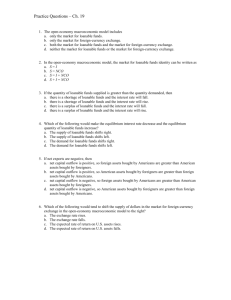Exercises for Chapter 26
advertisement
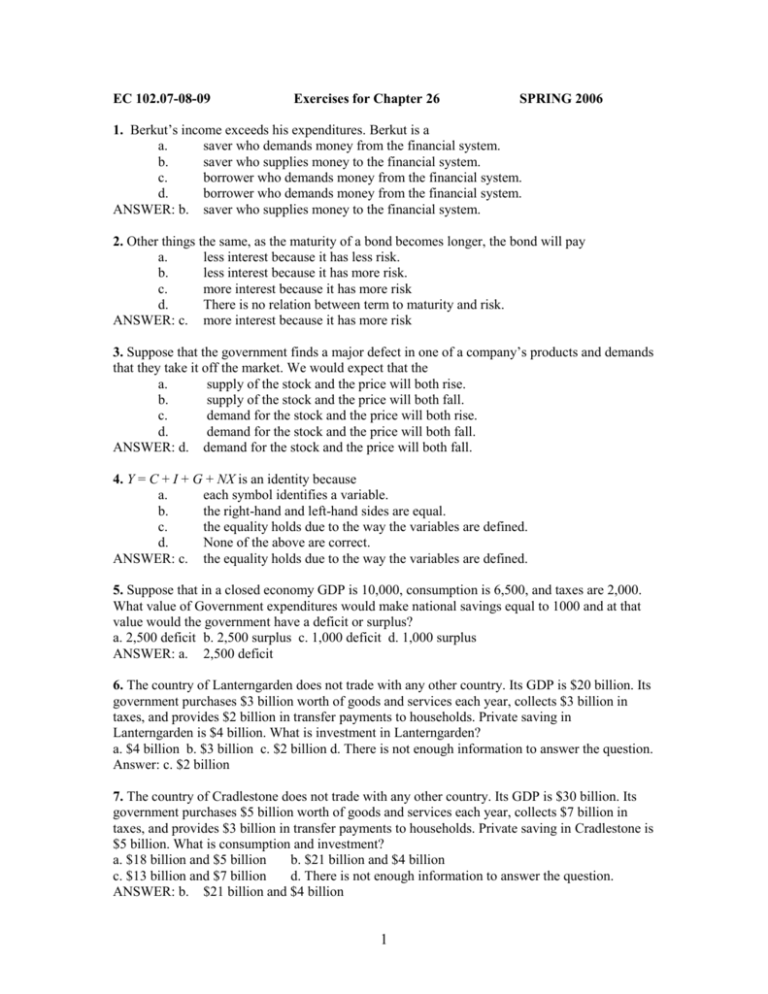
EC 102.07-08-09 Exercises for Chapter 26 SPRING 2006 1. Berkut’s income exceeds his expenditures. Berkut is a a. saver who demands money from the financial system. b. saver who supplies money to the financial system. c. borrower who demands money from the financial system. d. borrower who demands money from the financial system. ANSWER: b. saver who supplies money to the financial system. 2. Other things the same, as the maturity of a bond becomes longer, the bond will pay a. less interest because it has less risk. b. less interest because it has more risk. c. more interest because it has more risk d. There is no relation between term to maturity and risk. ANSWER: c. more interest because it has more risk 3. Suppose that the government finds a major defect in one of a company’s products and demands that they take it off the market. We would expect that the a. supply of the stock and the price will both rise. b. supply of the stock and the price will both fall. c. demand for the stock and the price will both rise. d. demand for the stock and the price will both fall. ANSWER: d. demand for the stock and the price will both fall. 4. Y = C + I + G + NX is an identity because a. each symbol identifies a variable. b. the right-hand and left-hand sides are equal. c. the equality holds due to the way the variables are defined. d. None of the above are correct. ANSWER: c. the equality holds due to the way the variables are defined. 5. Suppose that in a closed economy GDP is 10,000, consumption is 6,500, and taxes are 2,000. What value of Government expenditures would make national savings equal to 1000 and at that value would the government have a deficit or surplus? a. 2,500 deficit b. 2,500 surplus c. 1,000 deficit d. 1,000 surplus ANSWER: a. 2,500 deficit 6. The country of Lanterngarden does not trade with any other country. Its GDP is $20 billion. Its government purchases $3 billion worth of goods and services each year, collects $3 billion in taxes, and provides $2 billion in transfer payments to households. Private saving in Lanterngarden is $4 billion. What is investment in Lanterngarden? a. $4 billion b. $3 billion c. $2 billion d. There is not enough information to answer the question. Answer: c. $2 billion 7. The country of Cradlestone does not trade with any other country. Its GDP is $30 billion. Its government purchases $5 billion worth of goods and services each year, collects $7 billion in taxes, and provides $3 billion in transfer payments to households. Private saving in Cradlestone is $5 billion. What is consumption and investment? a. $18 billion and $5 billion b. $21 billion and $4 billion c. $13 billion and $7 billion d. There is not enough information to answer the question. ANSWER: b. $21 billion and $4 billion 1 8. Which of the following is not always correct in a closed economy? a. National saving equals private saving plus public saving. b. Net exports equal zero. c. Real GDP measures both income and expenditures. d. Private saving equals investment. ANSWER: d. Private saving equals investment. 9. Volkan is considering expanding his sütlaç shop. If interest rates rise he is a. less likely to expand. This illustrates why the supply of loanable funds slopes downward. b. more likely to expand. This illustrates why the supply of loanable funds slopes upward. c. less likely to expand. This illustrates why the demand for loanable funds slopes downward. d. more likely to expand. This illustrates why the demand for loanable funds slopes upward. ANSWER: c. less likely to expand. This illustrates why the demand for loanable funds slopes downward. 10. The supply of loanable funds slopes a. upward because an increase in the interest rate induces people to save more. b. downward because an increase in the interest rate induces people to save less. c. downward because an increase in the interest rate induces people to invest less. d. upward because an increase in the interest rate induces people to invest more. ANSWER: a. upward because an increase in the interest rate induces people to save more. 11. If the current market interest rate for loanable funds is below the equilibrium level, then the quantity of loanable funds a. demanded will exceed the quantity of loanable funds supplied and the interest rate will rise. b. supplied will exceed the quantity of loanable funds demanded and the interest rate will rise. c. demanded will exceed the quantity of loanable funds supplied and the interest rate will fall. d. supplied will exceed the quantity of loanable funds demanded and the interest rate will fall. ANSWER: a. demanded will exceed the quantity of loanable funds supplied and the interest rate will rise. 12. If the current market interest rate for loanable funds is above the equilibrium level, then there is a a. surplus of loanable funds and the interest rate will rise. b. shortage of loanable funds and the interest rate will rise. c. shortage of loanable funds and the interest rate will fall. d. surplus of loanable funds and the interest rate will fall. ANSWER: d. surplus of loanable funds and the interest rate will fall. 13. If there is surplus of loanable funds, then a. the supply for loanable funds shifts right and the demand shifts left. b. the supply for loanable funds shifts left and the demand shifts right. c. neither curve shifts, but the quantity of loanable funds supplied increases and the quantity demanded decreases as the interest rate rises to equilibrium. d. neither curve shifts, but the quantity of loanable funds supplied decreases and the quantity demanded increases as the interest rate falls to equilibrium. ANSWER: d. neither curve shifts, but the quantity of loanable funds supplied decreases and the quantity demanded increases as the interest rate falls to equilibrium. 2 15. The nominal interest rate is 6 percent and the real interest rate is 2 percent, what is the inflation rate? a. 8 percent b. 4 percent c. 3 percent d. None of the above are correct. ANSWER: b. 4 percent 16. What would happen in the market for loanable funds if the government were to decrease the tax rate on interest income? a. The supply of and demand for loanable funds would shift right. b. The supply of and demand for loanable funds would shift left. c. The supply of loanable funds would shift right and the demand for loanable funds would shift left. d. None of the above are correct. ANSWER: d. None of the above are correct. 17. If Turkey increases its budget deficit, it will reduce a. private saving and so shift the supply of loanable funds left. b. investment and so shift the demand for loanable funds left. c. public saving and so shift the supply of loanable funds left. d. None of the above are correct. ANSWER: c. public saving and so shift the supply of loanable funds left. 18. An increase in the budget deficit would cause a a. shortage of loanable funds at the original interest rate, which would lead to falling interest rates. b. surplus of loanable funds at the original interest rate, which would lead to rising interest rates. c. shortage of loanable funds at the original interest rate, which would lead to rising interest rates. d. surplus of loanable funds at the original interest rate, which would lead to falling interest rates. ANSWER: c. shortage of loanable funds at the original interest rate, which would lead to rising interest rates. 19. Between 2000 and 2001 the debt of Bolivia rose. Other things the same, we would expect that interest rates a. and investment rose. b. rose and investment fell. c. fell and investment rose. d. and investment fall. ANSWER: b. rose and investment fell. 20. When the government runs a budget deficit, a. interest rates are lower than they would be otherwise. b. national saving is higher than it would be otherwise. c. investment is lower than it would be otherwise. d. All of the above are correct. ANSWER: c. investment is lower than it would be otherwise. 21. Investment rises and interest rates fall. Which of the following could explain these changes? a. The government went from surplus to deficit. b. The government instituted an investment tax credit. c. The government reduced the tax rate on savings. d. None of the above are correct. ANSWER: c. The government reduced the tax rate on savings. 3 22. Use the figure below for the next two questions. I. Which of the graphs in the figure above shows the effects of an increase in the tax rate on saving? a. graph 1 b. graph 2 c. graph 3 d. None of the above are correct. ANSWER: a. graph 1 II. Which of the graphs in the figure above shows the effects of instituting a national sales tax and simultaneously lowering the income tax rate? a. graph 1 b. graph 2 c. graph 3 d.None of the above are correct. ANSWER: b. graph 2 23. Identify each of the following acts as representing either saving or investment. a. Joe uses some of his income to buy government bonds. b. Jack takes some of his income and buys mutual funds. c. William purchases a new truck for his delivery business using borrowed funds. d. Avarel uses some of his income to buy stock in a major corporation, e. Pot Poker hires a builder to construct a new home using borrowed funds. ANSWER: a. Joe is saving. b. Jack is saving. c. William is investing. d. Avarel is saving. e. Pot Poker is investing. 24. Australia has recently implemented a national sales tax. If they use the proceeds from this tax to reduce income tax rates, what happens in the loanable funds market? ANSWER: The supply of loanable funds shifts right. This causes the interest rate to fall. Both investment and saving rise. 25. Using a graph representing the market for loanable funds, show and explain what happens to interest rates and investment if a government goes from a deficit to a surplus. ANSWER: As shown in the graph below, the economy starts in equilibrium at point E0 with interest rate r0 and equilibrium quantity of saving and investment at q0. If the government succeeds in obtaining a surplus, there will be more public saving in the economy at each interest rate, and the supply of loanable funds curve will shift from S0 to S1. The new equilibrium will be 4 at E1, with a lower interest rate, r1 and a higher quantity of saving and investment, q1. Hence, if the federal government succeeds in having a surplus, interest rates will fall and investment will increase. Market for Loanable Funds 5

